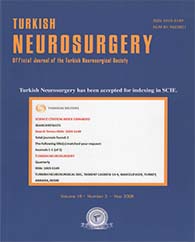2,3,6 Mersin University, Biochemistry, Mersin, Turkey
7 Dışkapı Yıldırım Beyazit Education and Research Hospital, Neurosurgery, Ankara, Turkey OBJECTIVE: Hypersecretion of prolactin (PRL) by lactotroph cells of the anterior pituitary may lead to hyperprolactinemia in physiological or pathological conditions. However, some of the patients may present with another cause of hyperprolactinemia, described by various authors as macroprolactinemia.
PATIENTS and METHODS: The clinical, radiological and biochemical assessment of 124 patients were carefully evaluated for differential diagnosis in light of the literature. Macroprolactinemia was assessed by the polyethylene glycol (PEG) method in all of the patients, with high PRL level but without significant symptomatology, presenting to our clinic between 2004 and 2006.
RESULTS: The sera from 124 patients with hyperprolactinemia were screened for macroprolactinemia using the PEG method and macroprolactinemia was detected in 10 patients (8%). The average age of the patients was 35 years (range 23-46). Nine of the ten patients were female (90%) and one was male (10%). All of the patients had MRI. An intrasellar mass and stalk lipoma were found in three of the ten patients (30%).
CONCLUSIONS: In conclusion, macroprolactinemia should be taken into consideration as a probable cause of high serum prolactin levels to avoid repeated hormone assessments, neuroradiological examinations and unnecessary medical and surgical treatments.
Keywords : Macroprolactinemia, Prolactin, Prolactinoma




